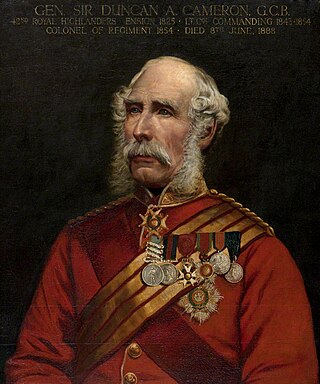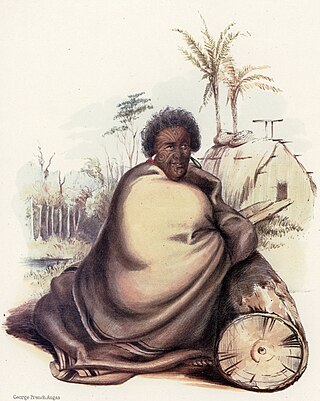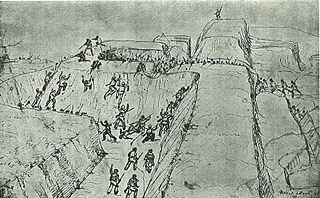Related Research Articles

The New Zealand Wars took place from 1845 to 1872 between the New Zealand colonial government and allied Māori on one side, and Māori and Māori-allied settlers on the other. Though the wars were initially localised conflicts triggered by tensions over disputed land purchases, they escalated dramatically from 1860 as the government became convinced it was facing united Māori resistance to further land sales and a refusal to acknowledge Crown sovereignty. The colonial government summoned thousands of British troops to mount major campaigns to overpower the Kīngitanga movement and also conquest of farming and residential land for British settlers. Later campaigns were aimed at quashing the Pai Mārire religious and political movement, which was strongly opposed to the conquest of Māori land and eager to strengthen Māori identity. Māori religious movements that promoted pan-Māori identity played a major role in the Wars.
The First Taranaki War was an armed conflict over land ownership and sovereignty that took place between Māori and the Colony of New Zealand in the Taranaki region of New Zealand's North Island from March 1860 to March 1861.
The Second Taranaki War is a term used by some historians for the period of hostilities between Māori and the New Zealand Government in the Taranaki district of New Zealand between 1863 and 1866. The term is avoided by some historians, who either describe the conflicts as merely a series of West Coast campaigns that took place between the Taranaki War (1860–1861) and Titokowaru's War (1868–69), or an extension of the First Taranaki War.

The invasion of the Waikato became the largest and most important campaign of the 19th-century New Zealand Wars. Hostilities took place in the North Island of New Zealand between the military forces of the colonial government and a federation of Māori tribes known as the Kingitanga Movement. The Waikato is a territorial region with a northern boundary somewhat south of the present-day city of Auckland. The campaign lasted for nine months, from July 1863 to April 1864. The invasion was aimed at crushing Kingite power and also at driving Waikato Māori from their territory in readiness for occupation and settlement by European colonists. The campaign was fought by a peak of about 14,000 Imperial and colonial troops and about 4,000 Māori warriors drawn from more than half the major North Island tribal groups.

Tainui is a tribal waka confederation of New Zealand Māori iwi. The Tainui confederation comprises four principal related Māori iwi of the central North Island of New Zealand: Hauraki, Ngāti Maniapoto, Ngāti Raukawa and Waikato. There are other Tainui iwi whose tribal areas lay outside the traditional Tainui boundaries – Ngāi Tai in the Auckland area, Ngāti Raukawa ki Te Tonga and Ngāti Toa in the Horowhenua, Kāpiti region, and Ngāti Rārua and Ngāti Koata in the northern South Island.

The Tauranga campaign was a six-month-long armed conflict in New Zealand's Bay of Plenty in early 1864, and part of the New Zealand Wars that were fought over issues of land ownership and sovereignty. The campaign was a sequel to the invasion of Waikato, which aimed to crush the Māori King (Kingitanga) Movement that was viewed by the colonial government as a challenge to the supremacy of the British monarchy.

The Waikato is a region of the upper North Island of New Zealand. It covers the Waikato District, Waipa District, Matamata-Piako District, South Waikato District and Hamilton City, as well as Hauraki, Coromandel Peninsula, the northern King Country, much of the Taupō District, and parts of the Rotorua Lakes District. It is governed by the Waikato Regional Council.

General Sir Duncan Alexander Cameron, was a British Army officer who fought in the Crimean War and part of the New Zealand Wars. He was later a governor of the Royal Military College, Sandhurst.

KīngiTāwhiao, known initially as Matutaera, reigned as the Māori King from 1860 until his death. After his flight to the King Country, Tāwhiao was also Paramount Chief of Te Rohe Pōtae for 17 years, until 1881. A rangatira, and a religious figure - a tohunga ariki - Tāwhiao amassed power and authority during a time of momentous change, to become de facto leader of the Waikato tribes. He was a member of the Ngati Mahuta hapū and the kāhui ariki, the Kīngitanga royal family.

Tuakau is a town in the Waikato region at the foot of the Bombay Hills, formerly part of the Franklin District until 2010, when it became part of Waikato District in the North Island of New Zealand. The town serves to support local farming, and is the residence of many employees of New Zealand Steel at Glenbrook.

The King Country is a region of the western North Island of New Zealand. It extends approximately from Kawhia Harbour and the town of Ōtorohanga in the north to the upper reaches of the Whanganui River in the south, and from the Hauhungaroa and Rangitoto Ranges in the east to near the Tasman Sea in the west. It comprises hill country, large parts of which are forested.

Pōtatau Te Wherowhero was a Māori rangatira who reigned as the inaugural Māori King from 1858 until his death. A powerful nobleman and a leader of the Waikato iwi of the Tainui confederation, he was the founder of the Te Wherowhero royal dynasty. His 1858 coronation followed years of efforts to create the Kīngitanga, a Māori monarchy intended as an equivalent of the British monarchy, and to foster Māori nationalism against settler encroachment.

Pukekawa is a town in the Lower Waikato River area of New Zealand's North Island, 66 km south of central Auckland. The area's fertile soils are used to grow a range of vegetables, including onions, potatoes and carrots. The town was in the Franklin District until the district's abolition in 2010.
The Defence of Pukekohe East was an action during the Invasion of the Waikato, part of the New Zealand Wars. On 13 September and 14 September 1863, 11 settlers and 6 militia men inside a half-completed stockade around the Pukekohe East church held off a Māori taua or war party of approximately 200 men from Ngāti Maniapoto and Ngāti Pou iwi, until they were relieved by detachments of the 18th, 65th and 70th Regiments. In a series of actions around the stockade the taua sustained 20% casualties and retreated.

Rewi Manga Maniapoto (1807–1894) was a Ngāti Maniapoto chief who led Kīngitanga forces during the New Zealand government Invasion of Waikato during the New Zealand Wars.

Ngāti Hauā is a Māori iwi of the eastern Waikato of New Zealand. It is part of the Tainui confederation. Its traditional area includes Matamata, Cambridge, Maungakawa, the Horotiu district along the Waikato River and the Maungatautari district, and its eastern boundary is the Kaimai Range. Leaders of the tribe have included Te Waharoa, his son Wiremu Tamihana and Tamihana's son Tupu Taingakawa. The tribe has played a prominent role in the Māori King Movement, with Tamihana and descendants being known as the "Kingmakers".

The Battle of Rangiriri was a major engagement in the invasion of Waikato, which took place on 20–21 November 1863 during the New Zealand Wars. More than 1400 British troops defeated about 500 warriors of the Kingitanga, which was resisting the expansion of British settlement and colonial rule in the North Island. The battle cost both sides more than any other engagement of the land wars and also resulted in the capture of 180 Māori prisoners, further reducing the Kingitanga ability to oppose the far larger British force.

Wiremu Te Morehu Maipapa Te Wheoro (1826–1895), also known as Major Te Wheoro and later as Wiremu Te Morehu or William Morris, was a 19th-century Māori member of the House of Representatives.

Waata Pihikete Kukutai was a New Zealand Māori tribal leader, farmer and assessor. He identified with the Ngāti Tipa and Waikato iwi.

Alexandra Redoubt is a fortification of the New Zealand Wars, located at Tuakau, New Zealand. Overlooking the Waikato River, it was built to protect the British supply routes during the Invasion of the Waikato. Erected in July 1863, it was garrisoned until October the following year at which time it was abandoned. It is now a historic reserve.
References
- ↑ Ryan & Parham p. 212
- The New Zealand Wars: and the Victorian Interpretation of Racial Conflict by James Belich pp. 121,136,137 (1986, Auckland University Press, Auckland) ISBN 1-86940-002-X
- The Colonial New Zealand Wars by Tim Ryan and Bill Parham p. 212 (1986, Wellington, Grantham House) ISBN 1-86934-006-X